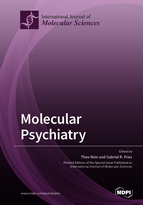Molecular Psychiatry
A special issue of International Journal of Molecular Sciences (ISSN 1422-0067). This special issue belongs to the section "Molecular Pathology, Diagnostics, and Therapeutics".
Deadline for manuscript submissions: closed (31 March 2019) | Viewed by 134405
Special Issue Editors
Interests: biochemistry, genetics and molecular biology; medicine; neuroscience
Interests: epigenetics; bipolar disorder; aging; stress; DNA methylation; microRNAs; biomarkers
Special Issues, Collections and Topics in MDPI journals
Special Issue Information
Dear Colleagues,
Understanding the molecular underpinnings of the pathophysiology of psychiatric disorders remains a challenging task. Nevertheless, the field of molecular psychiatry has greatly benefitted from the rapid technological advancements over the last few years. Moreover, the need for translational approaches combining expertise from different fields (such as molecular and cellular biology, biochemistry, chemical biology, genetics, epigenetics, psychology, psychiatry, neurology, electrophysiology, pharmacology, and bioinformatics including advanced machine learning techniques) is increasingly recognized and implemented. As a result, significant progress has been made in deciphering the genetic and epigenetic basis of psychiatric disorders at unprecedented resolution. This is complemented by mechanistic work in cellular and animal models, imaging studies, the identification of additional markers at the level of RNA and protein, as well as functional insight from animal models. A more comprehensive molecular understanding of psychiatric diseases also is a prerequisite for the rational development of new drugs and treatment strategies.
We invite researchers to submit high quality manuscripts presenting original research or expert review articles on the scientific advances in the area of molecular psychiatry. We encourage submissions addressing the role of molecular, genetic, epigenetic and biochemical mechanisms on all aspects related to pathophysiology, vulnerability and resilience, response to treatment, prognosis, pharmacology and progression of psychiatric disorders. Both human and preclinical studies will be considered.
Dr. Theo Rein
Dr. Gabriel R. Fries
Guest Editors
Manuscript Submission Information
Manuscripts should be submitted online at www.mdpi.com by registering and logging in to this website. Once you are registered, click here to go to the submission form. Manuscripts can be submitted until the deadline. All submissions that pass pre-check are peer-reviewed. Accepted papers will be published continuously in the journal (as soon as accepted) and will be listed together on the special issue website. Research articles, review articles as well as short communications are invited. For planned papers, a title and short abstract (about 100 words) can be sent to the Editorial Office for announcement on this website.
Submitted manuscripts should not have been published previously, nor be under consideration for publication elsewhere (except conference proceedings papers). All manuscripts are thoroughly refereed through a single-blind peer-review process. A guide for authors and other relevant information for submission of manuscripts is available on the Instructions for Authors page. International Journal of Molecular Sciences is an international peer-reviewed open access semimonthly journal published by MDPI.
Please visit the Instructions for Authors page before submitting a manuscript. There is an Article Processing Charge (APC) for publication in this open access journal. For details about the APC please see here. Submitted papers should be well formatted and use good English. Authors may use MDPI's English editing service prior to publication or during author revisions.
Keywords
- Biological psychiatry
- Neuropsychopharmacology
- Genetics
- Epigenetics
- Molecular biology
- Cell biology
- Animal models
- Biomarkers
- Signal transduction
- Treatment response








